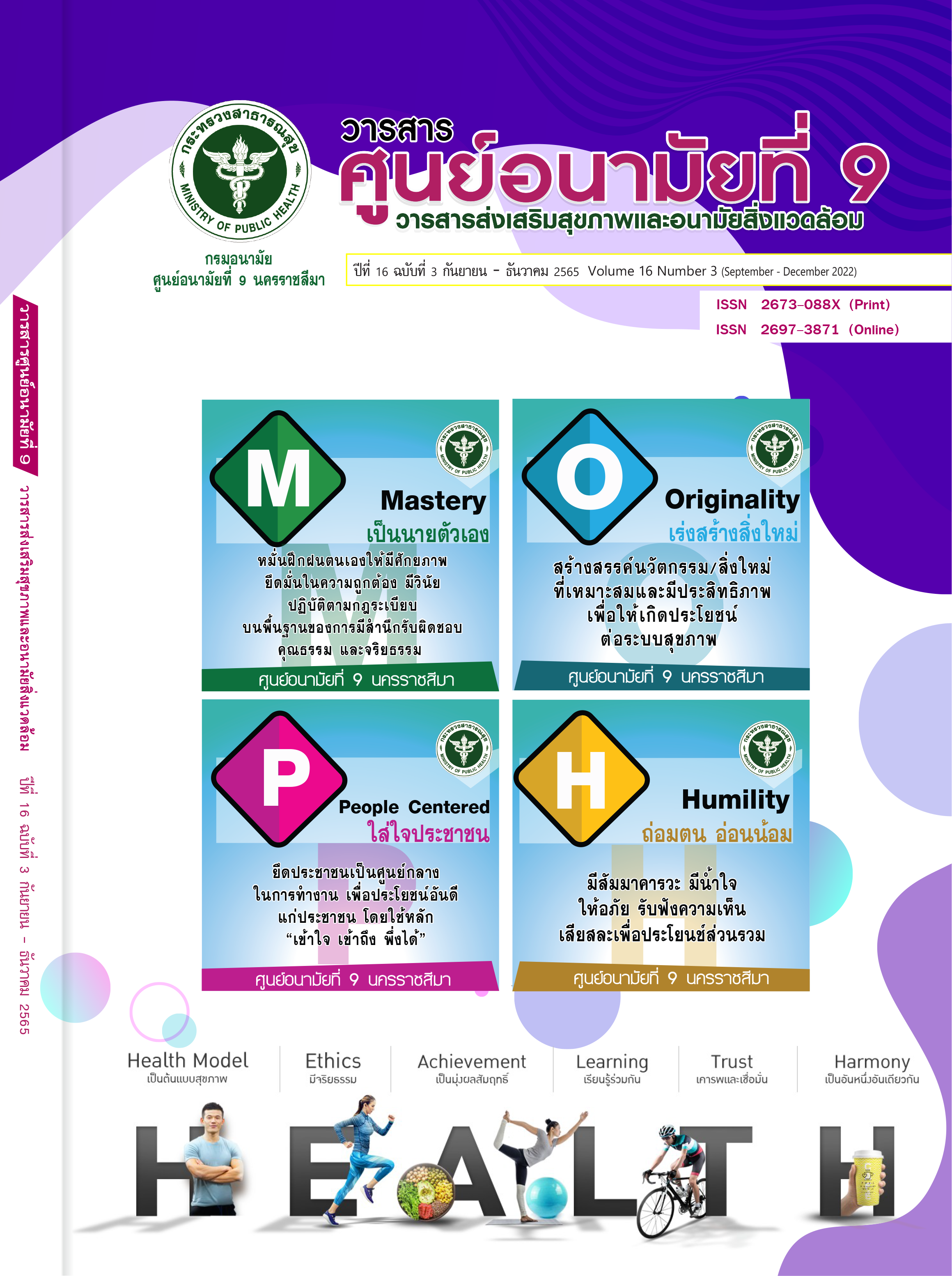ผลของการใช้โปรแกรมการส่งเสริมการจัดการความเจ็บปวดจากการคลอด ต่อคะแนนความเจ็บปวดและการรับรู้ประสบการณ์คลอด ของหญิงวัยรุ่นในระยะคลอด
คำสำคัญ:
โปรแกรมการส่งเสริมการจัดการความเจ็บปวดจากการคลอด, การรับรู้ประสบการณ์การคลอด, หญิงวัยรุ่นในระยะคลอดบทคัดย่อ
การวิจัยกึ่งทดลองครั้งนี้ มีวัตถุประสงค์เพื่อศึกษาผลของการใช้โปรแกรมการส่งเสริมการจัดการความเจ็บปวดจากการคลอดต่อคะแนนความเจ็บปวดและการรับรู้ประสบการณ์คลอดของหญิงวัยรุ่นในระยะคลอด กลุ่มตัวอย่าง คือหญิงวัยรุ่นในระยะคลอด ที่มารับบริการการคลอดในโรงพยาบาลภูมิพลอดุลยเดช ตั้งแต่ สิงหาคม 2563 ถึง พฤษภาคม 2564 เลือกกลุ่มตัวอย่างแบบเฉพาะเจาะจงทั้งหมด จำนวน 60 คน แบ่งเป็นกลุ่มควบคุม 30 คน และกลุ่มทดลอง 30 คน เครื่องมือที่ใช้เก็บรวบรวมข้อมูล ใช้แบบสอบถามการรับรู้ประสบการณ์การคลอด 2 ส่วน ได้แก่ 1) ข้อมูลทั่วไป 2) แบบสอบถามประสบการณ์เกี่ยวกับการคลอดของผู้คลอด ตรวจสอบหาความตรงตามเนื้อหาโดยผู้ทรงคุณวุฒิ 3 ท่าน ได้ค่าดัชนีความตรงตามเนื้อหา (CVI) เท่ากับ 0.85 และหาค่าความเที่ยงของแบบสอบถามประสบการณ์เกี่ยวกับการคลอดของผู้คลอด ได้ค่าสัมประสิทธิ์แอลฟาของครอนบาค (Cronbach’s alpha coefficient) ทั้งฉบับเท่ากับ 0.93 วิเคราะห์ข้อมูลโดยใช้สถิติ ค่าเฉลี่ย ร้อยละ ส่วนเบี่ยงเบนมาตรฐาน และสถิติทีแบบอิสระต่อกัน (Independent t-test)
ผลการวิจัยพบว่า ค่าเฉลี่ยความเจ็บปวดช่วงปากมดลูกเปิด 4-7 ซม. ของทั้งสองกลุ่มแตกต่างกัน อย่างมีนัยสำคัญทางสถิติที่ p=0.05 ในขณะที่ค่าเฉลี่ยความเจ็บปวดช่วงปากมดลูกเปิด 8-10 ซม. ของทั้งสองกลุ่มไม่แตกต่างกัน และเมื่อเปรียบเทียบค่าเฉลี่ยคะแนนการรับรู้ประสบการณ์การคลอดระหว่างกลุ่มควบคุมและกลุ่มทดลอง ในกลุ่มควบคุมมีค่าเฉลี่ย 120.00 คะแนน และกลุ่มทดลองมีค่าเฉลี่ย 116.23 คะแนน โดยสรุป คะแนนเฉลี่ยของทั้งสองกลุ่มไม่แตกต่างกัน
เอกสารอ้างอิง
Siyoum M, Mekonnen S. Labor pain control and associated factors among women who gave birth at Leku primary hospital, southern Ethiopia. BMC Res Notes. 2019;12(1):619. Published 2019 Sep 23. doi:10.1186/s13104-019-4645-x
Tzeng YL, Yang YL, Kuo PC, Lin YC, Chen SL. Pain, Anxiety, and Fatigue During Labor: A Prospective, Repeated Measures Study. J Nurs Res. 2017;25(1):59-67. doi:10.1097/jnr.0000000000000165
Alqattan H, Cleland J, Morrison Z. An evaluation of patient safety culture in a secondary care setting in Kuwait. Journal of Taibah University Medical Sciences. 2018;13(3):272-80.
World Health Organization [Internet]. Adolescent pregnancy [Fact sheet 2018]. 2018 [cited 2020 Mar. 4]. Available from: http://www.who.int/en/news-room/fact-sheets/detail/adolescent-pregnancy
Khwepeya, M., Lee, G. T., Chen, S. R., & Kuo, S. Y. Childbirth fear and related factors among pregnant and postpartum women in Malawi. BMC pregnancy and childbirth.2018;18(1):391. https://doi.org/10.1186/s12884-018-2023-7
Sauls D. J. Adolescents' perception of support during labor. The Journal of Perinatal Education. 2004;13(4):36–42. https://doi.org/10.1624/105812404X6216
Steel, A., Adams, J., Sibbritt, D., Broom, A., Gallois, C., & Frawley, J. Managing the pain of labour: factors associated with the use of labour pain management for pregnant Australian women. Health expectations : An international journal of public participation in health care and health policy. 2015;18(5):1633-44. https://doi.org/10.1111/hex.12155
Lowdermilk D, Cashion MC, Perry C, Alden K, Olshansky E. Maternity & Women’s Health Care. 10th ed. St Louis: Elsevier Mosby; 2011: 369-85.
Thomson G, Feeley C, Moran VH, Downe S, Oladapo OT. Women's experiences of pharmacological and non-pharmacological pain relief methods for labour and childbirth: a qualitative systematic review. Reprod Health. 2019;16(1):71. doi:10.1186/s12978-019-0735-4
Parisunyakul S, Baosoung C, Prasitwatanasaree P. Predictors of Women’s Perceptions of the Positive Childbirth Experience. Nursing Journal 2013;45:84-93.
Iliadou M. Supporting women in labour. Health Science Journal. 2012;6:385-91.
Chuchuay B. The effects of continuous support program in labor by nurses on pain levels and pain coping behaviors in primiparous adolescents. Songkla: Prince of Songkla University; 2015.
Khwanmueang P, Chunuan S, Thitimapong B. Effect of Childbirth Preparation Program with Continuous Labor Support on Labor Pain of First-Time Teenage Pregnant Women. Nursing Journal of The Ministry of Public Health. 2020;30(3):115-27.
Khamvongsa J. The Effects of Continuous Support Program During Labor by Nurses on Pain Levels and Pain Coping Behaviors in Primiparous Adolescents at Buengkan Hospital. Udonthani Hospital Medical Journal. 2018;26(3):164-75.
Marut JS, Mercer RT. Comparison of primiparas' perceptions of vaginal and cesarean births. Nurs Res. 1979;28(5):260-6.
Karapakdee C, Deoisres W, Chuahorm U. Effects of Labor Support Program by a Female Relative on Fear of Childbirth and Perception of Childbirth Experience Among First-time Adolescent Mothers. The Journal of Faculty of Nursing Burapha University. 2019;27(2):20-9.
Subprasert Y. Effects of Nursing Care Using Nonpharmacological Technique of Pain Relief on Pain Coping Behaviors During Delivery, Duration of Labor and Perception of Childbirth Experience in Primiparas. Graduate School: Chulalongkorn University; 1998.
Cunningham FG, Leveno KJ, Bloom SL, Hauth JC, Rouse DJ, Spong CY. William’s Obstetrics. 25th ed. New York: McGraw-Hill; 2017.
Budsaengdee B, Chankhao C. Effect of Using an Application for Enhancing Childbirth Self-efficacy to Cope with Labor Pain and Perception of The Childbirth Experience of Nulliparous Pregnant Adolescents. Thai Red Cross Nursing Journal. 2021;14(1):241-55.
ดาวน์โหลด
เผยแพร่แล้ว
รูปแบบการอ้างอิง
ฉบับ
ประเภทบทความ
สัญญาอนุญาต
ลิขสิทธิ์ (c) 2022 วารสารศูนย์อนามัยที่ 9 : วารสารส่งเสริมสุขภาพและอนามัยสิ่งแวดล้อม

อนุญาตภายใต้เงื่อนไข Creative Commons Attribution-NonCommercial-NoDerivatives 4.0 International License.
บทความหรือข้อคิดเห็นใด ๆ ที่ประกฎในวารสารศูนย์อนามัยที่ 9 เป็นความคิดเห็นของผู้เขียน บรรณาธิการ คณะผู้จัดทำ และศูนย์อนามัยที่ 9 นครราชสีมา (เจ้าของ) ไม่จำเป็นต้องเห็นด้วย ผู้เขียนต้องรับผิดชอบต่อบทความของตนเอง
ผลการพิจารณาของกองบรรณาธิการและผู้ทรงคุณวุฒิถือเป็นที่สิ้นสุด คณะบรรณาธิการวารสารฯ ขอสงวนสิทธิ์ในการตรวจแก้ไขข้อความให้ถูกต้องตามหลักภาษาและมีความเหมาะสม
กองบรรณาธิการวารสารฯ ขอสงวนสิทธิ์มิให้นำเนื้อหาใด ๆ ของบทความ หรือข้อคิดเห็นใด ๆ ของผลการประเมินบทความในวารสารฯ ไปเผยแพร่ก่อนได้รับอนุญาตจากกองบรรณาธิการ อย่างเป็นลายลักษณ์อักษร และผลงานที่ได้รับการตีพิมพ์ถือเป็นลิขสิทธิ์ของวารสารศูนย์อนามัยที่ 9


